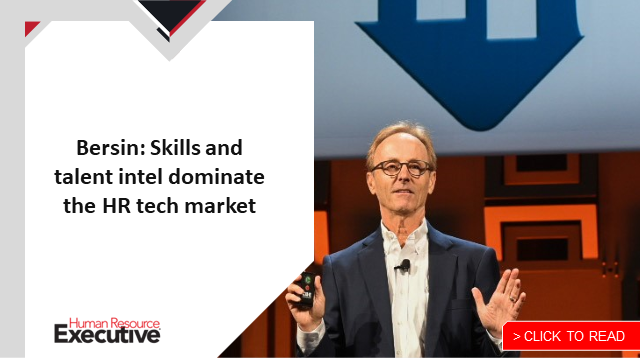This is the third of a three-part series which includes how to buy HR tech and how to implement HR tech. I’m dedicating three of my HRE columns to this topic area, as it was the most recurring conversation I heard at September’s HR Tech Conference in Las Vegas.
Own the narrative
If you’ve ever worked in a mid-to-large size organization before, you know how quickly a whisper campaign about an initiative, strategy or new executive can spiral out of control. How people perceive something (often with little data) shapes how they feel about it, how they talk about it and what they do to either support or resist it.
That’s why we must be vigilant about the collective interpretation of our systems implementations. I’ve seen too many instances where a solid platform and a decent implementation will derail into a shared belief that it was a failure and that “we need a new system,” ushering in a massive new amount of work, cost and risk.
With few exceptions, the results of your initial rollout won’t be as high as you were hoping—which, again, is less about the technology and more about just how damn hard it is to change behaviors, capture people’s attention and sustain improvement.
Celebrate success
In this phase, realize that you need to be the PR agent for the governing team around this effort, including executive champions, power users, early adopters and functional partners who supported the implementation.
Leverage your various internal communications channels—such as newsletters, intranets, facility signage or electronic boards, Teams/Slack, town halls or other company-wide reports/readouts like executive offsites or even board meetings—as opportunities to celebrate what’s going well.
 Executives are parched for good news (especially in this business climate), so gather and package up success stories with metrics to be shared. I’ll never forget a CEO I worked for who included my HR tech platform launch on his “quarterly wins” slide during a town hall to 25,000 people because we could link it to his strategy, set goals in advance and showed a 7X performance against them. All of a sudden, our success was his success!
Executives are parched for good news (especially in this business climate), so gather and package up success stories with metrics to be shared. I’ll never forget a CEO I worked for who included my HR tech platform launch on his “quarterly wins” slide during a town hall to 25,000 people because we could link it to his strategy, set goals in advance and showed a 7X performance against them. All of a sudden, our success was his success!
Protect the asset
A fundamental priority is to ensure that there is a budget for the platform in future years, so a close relationship with the finance team— including encouraging them to build the cost into future forecasts and budgets—is key. Also, working with vendors to provide special pricing for multi-year deals can help eliminate this being an annual chore or risk.
New executive hires can also be a threat, as they will oftentimes have had other platforms at prior firms they were familiar with or had success with. Quickly engaging with them in onboarding and helping them to get their goals met with your platform can be a great way to channel their energy from considering a platform change to using what’s built.
And keep in mind that sales teams from other vendors will be pitching anyone at your firm who will listen, so the more you keep selling the existing platform and communicate its efficacy, the faster you can cut such end runs off.
Expand impact
If you started with a proof of concept, pilot or demonstration, you’ll want to think about when and where you expand. What do you need to see to say, “This is working” (as I described in my last column)? And, “What is the most likely place to expand next?” I encourage you to avoid expanding to the teams or departments that might need the platform the most but would be the hardest to engage. Instead, focus on those most likely to adopt and engage with the technology quickly, so that you can build sustained momentum and save the hardest battles for when you have critical mass.
Expanding impact may involve deeper integrations with your other systems, leveraging new or additional functionality or modules from vendors, or rethinking how the system is configured based on new product releases or innovations. It’s also important to make sure you are protecting the data in your HR systems. According to TechTarget, “some of an enterprise’s most vulnerable systems are internal and third-party, or cloud, web applications that process HR and payroll records.” So, ensure your vendors are adopting reasonable industry standards around security and data privacy.
Modern, best-in-class technology platforms are living, breathing things—a huge contrast to the monolithic installed base software many of us first encountered in the workplace. Keep close contact with the customer success and product management teams at vendors so that you can be the first to test and use new functionality, and even help shape the features themselves.
Seek external validation
When possible, see if you can do things like co-present with a vendor at an industry conference, write an op-ed in a trade publication, post on your external company blog, tap into the company’s social media team for a LinkedIn shout out, do a case study, go for an award, get some earned media, guest on a podcast or do a brief lunch and learn with fellow external HR leaders about your progress. Going externally and having others validate the quality of the work and its impact is a clever way to shape perception internally.
Shelly Lazarus, the former chairman of Ogilvy & Mather, shared at a breakfast I attended that the secret to getting your employees excited about a major company initiative is to add “a dollop of external visibility, like a spoonful of sour cream on a baked potato.”
 And make sure to share the stage or spotlight with your colleagues in doing this. The best thing you can do is ask the governing team—including executive champions, power users and early adopters—to be the spokespeople for the platform’s real-world impact. People will remember you for creating opportunities for them to shine externally.
And make sure to share the stage or spotlight with your colleagues in doing this. The best thing you can do is ask the governing team—including executive champions, power users and early adopters—to be the spokespeople for the platform’s real-world impact. People will remember you for creating opportunities for them to shine externally.
A final word
If you take on the effort, risk and rollercoaster that is implementing an innovative HR tech platform, make sure you get rewarded for it! That might be in the form of your annual compensation, your internal visibility with higher-ups, special opportunities a vendor unlocks for you (while being compliant and transparent with any company policies, of course) and even on your LinkedIn and digital footprint.
Future career opportunities can be unlocked—internally or externally—when you own the critical part that you played in making this all happen. Doing anything new is always going to be at least 10 times harder than maintaining the status quo, so be sure to associate yourself as a change agent who helps prepare organizations for the future to remain competitive and be employers of choice. That is the future of work and of HR, my friends!
The post What you need to know about sustaining your new HR tech appeared first on HR Executive.